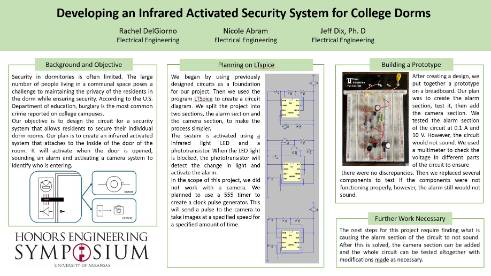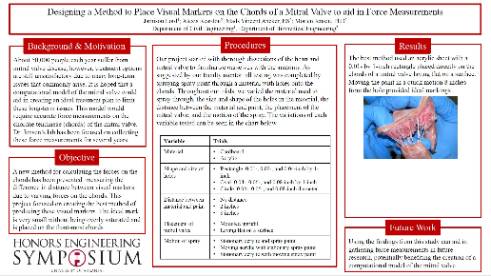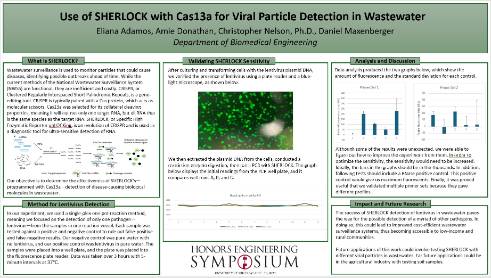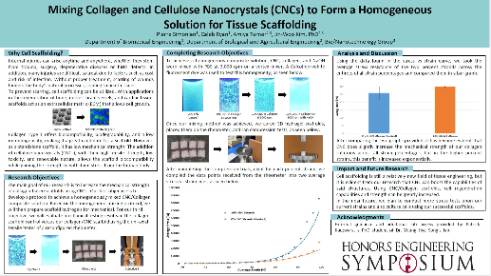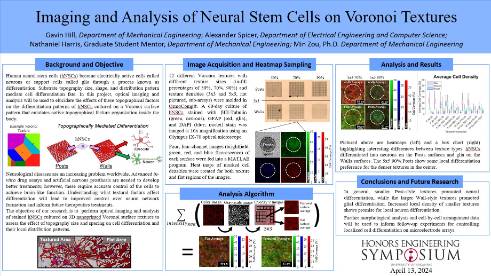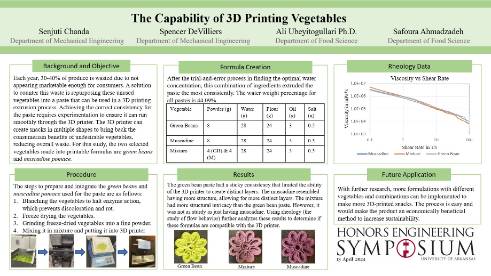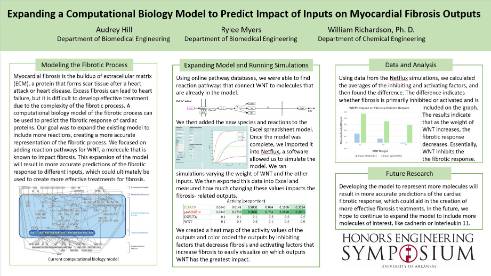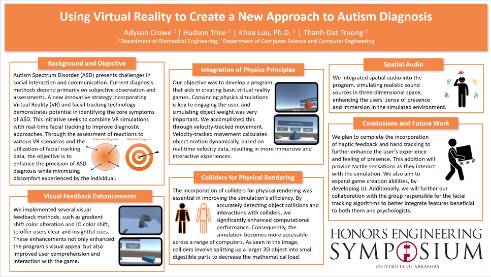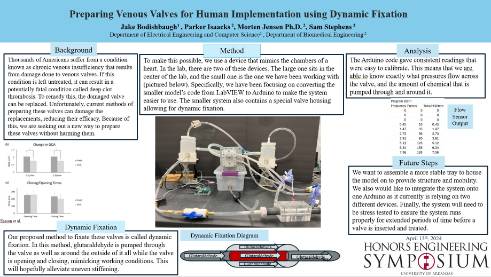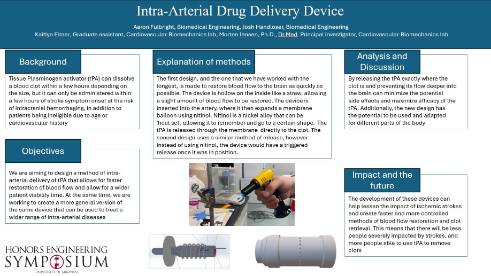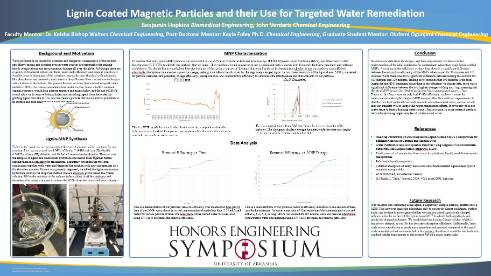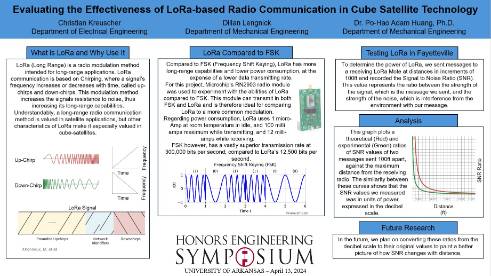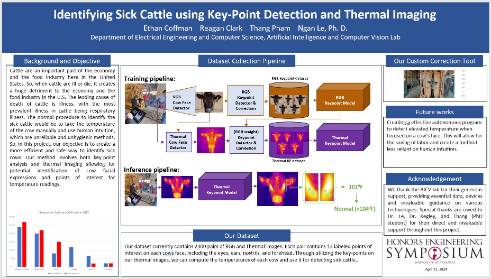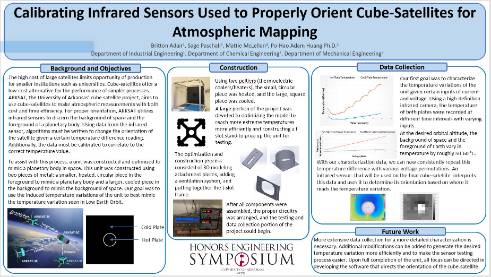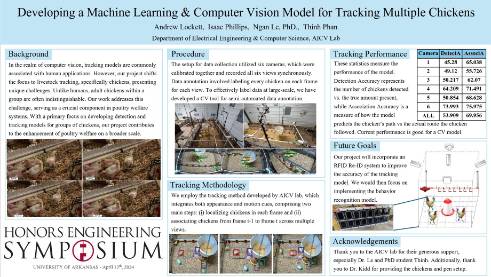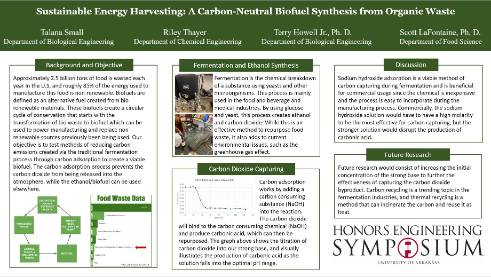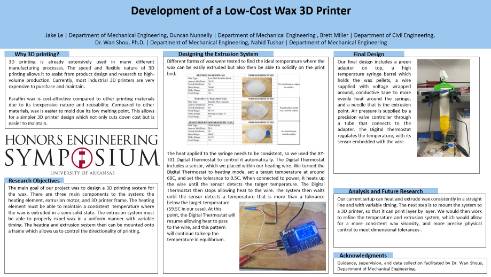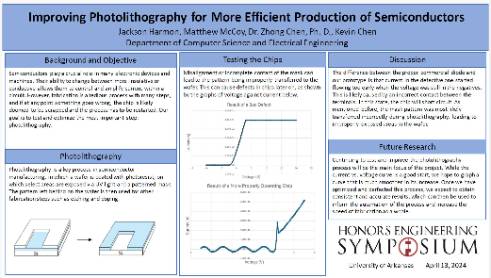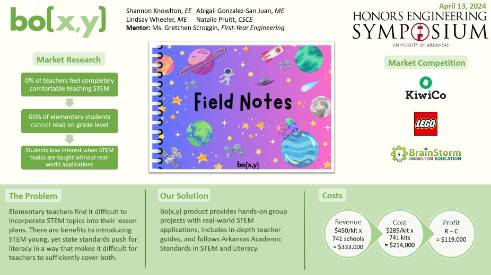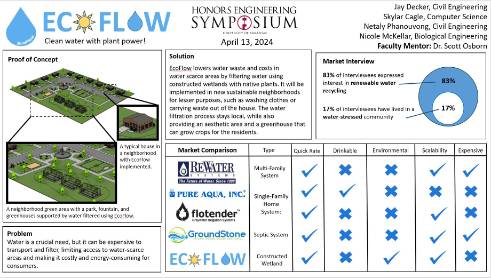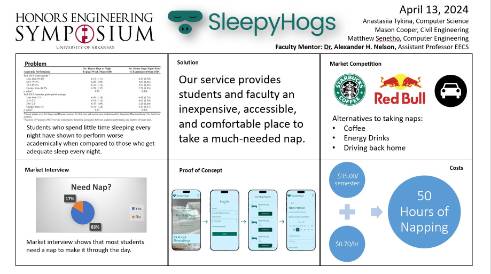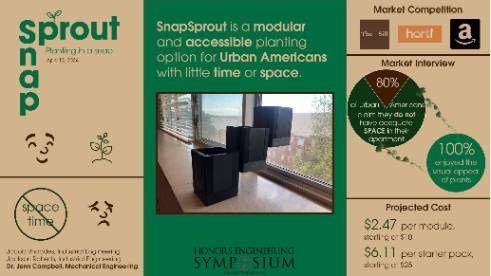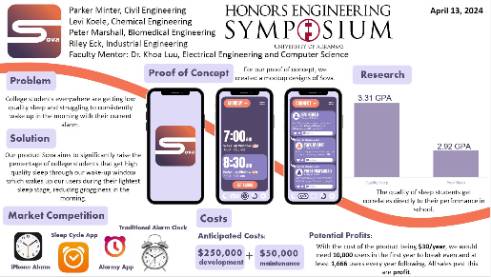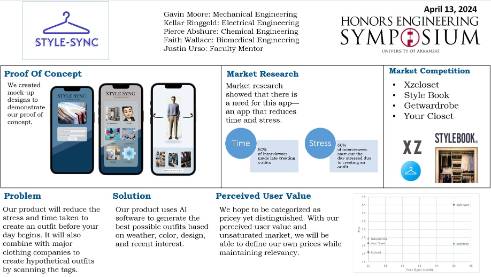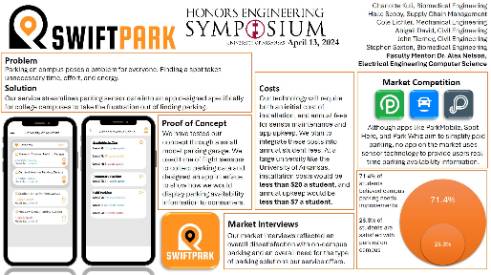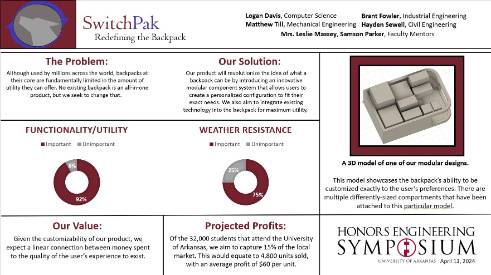Welcome from First-Year Engineering
On behalf of the College of Engineering at the University of Arkansas, it is with great pleasure that we extend a warm welcome to you for the 16th Annual Honors Engineering Symposium. This event spotlights the remarkable achievements of our talented Honors Research and Honors Innovation Experience students, who are part of the Honors College or Honors College Path program.
Throughout the academic year, 69 first-year students from the College of Engineering and Walton College of Business have worked on projects mentored by University of Arkansas faculty members. Engaging in rigorous research colloquia and innovation sessions, these students have learned about various aspects of academia, research, and innovation with unwavering dedication.
The culmination of their efforts will be showcased through 26 compelling research and innovative design projects, covering a diverse spectrum of engineering disciplines. From the intricacies of mechanical engineering to the complexities of electrical systems, each project reflects the passion, intellect, and ingenuity of our emerging engineers and business students.
As we convene for this symposium, attendees will have the opportunity to attend insightful presentations and interactive poster sessions. We encourage everyone to engage with our students, learn about their projects, and participate in vibrant discussions.
We again welcome you to our 16th Annual Honors Engineering Symposium and express our gratitude for your participation. Together, let us celebrate the spirit of inquiry, collaboration, and excellence that defines our vibrant academic community.
Sincerely,
Aysa Galbraith, Ph.D.
Coordinator of Honors Research Experience
Teaching Associate Professor of First-Year Engineering Program
Leslie Massey
Coordinator of Honors Innovation Experience
Advanced Instructor of First-Year Engineering Program
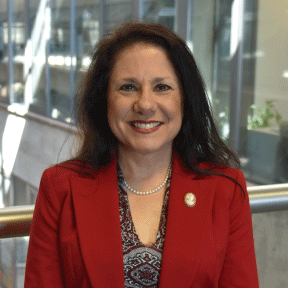
Welcome from the College of Engineering
Hello and welcome to the 16th Annual Honors Engineering Symposium. Today, we honor our students who are shaping the world of tomorrow! Participating in this symposium is a significant achievement, and you should be proud. Well done! You have gone above and beyond what is required of first-year students by choosing to participate in this research or innovation experience and for that we celebrate. Please enjoy the presentations and posters of those who will change research, product marketing and business development of the community, state, nation and the world.
Dean Kim LaScola Needy
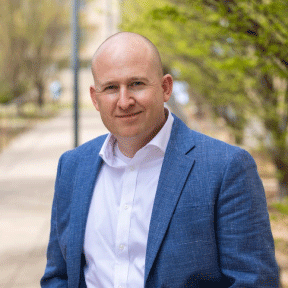
Welcome from the Sam M. Walton College of Business
Welcome to the Honors Engineering Symposium, which showcases the amazing efforts of first-year engineering and business students enrolled in the Honors College and Honors College Path programs. Innovation is one of the values of the Walton College, and I am delighted you have chosen this path. As we look towards the future, it's clear that an innovative and entrepreneurial mindset will be critical in a quickly changing economy. I look forward to the impact you will make, and I congratulate your outstanding work this year!
Dean Brent Williams
Research Teams
Developing an Infrared Activated Security System for College Dorms
Students
Nicole Abram | Electrical Engineering
Rachel DelGiorno | Electrical Engineering
Faculty Mentor
Dr. Jeff Dix | Electrical Engineering and Computer Science
Project Description
Security in dorms is often limited, which is a prevalent issue because burglary is the most reported crime on college and university campuses. We are designing a system that allows residents to secure their individual dorm rooms. An infrared security system alerts when it detects a change in the light emitted. The infrared system will attach to the door of the room, sounding an alarm and activating a camera system when the door is opened.
Designing a method to place visual markers on the chords of a mitral valve to aid in force measurements
Students
Alexis Reardon | Biomedical Engineering
Jamison Lord | Civil Engineering
Faculty Mentor
Morten Jensen, Ph.D. | Biomedical Engineering
Mads Vincent Anker, Graduate Student Mentor | Biomedical Engineering
Project Description
Currently, treatment options for mitral valve disease have many long-term issues. It is believed that using a patient-specific computational model of the mitral valve pre-treatment would alleviate this issue. This model requires accurate force measurements on the chords of the mitral valve, which can be calculated by measuring the difference in distance between visual markers due to multiple forces on the chords. This project focuses on creating the best method of producing these visual markers.
Use of SHERLOCK with Cas12a for viral particle detection in wastewater
Students
Eliana Adamos | Biomedical Engineering
Amie Donathan | Biomedical Engineering
Faculty Mentor
Christopher Nelson, Ph.D. | Biomedical Engineering
Daniel Maxenberger, Graduate Student Mentor | Biomedical Engineering
Project Description
Wastewater surveillance plays a significant role in identifying possible disease outbreaks before they happen. PCR is a process that wastewater surveillance teams use to amplify the DNA or RNA of the virus in the water, but this process is costly, inefficient, and inaccessible. This project aims to solve these problems by using SHERLOCK, a technology that utilizes CRISPR, to detect the RNA and release a readable reporter signal.
Mixing Collagen and Cellulose Nanocrystals (CNCs) to Form a Homogeneous Solution for Tissue Scaffolding
Students
Pierre Simonian | Biomedical Engineering
Caleb Ryan | Biomedical Engineering
Faculty Mentor
Dr. Jin-Woo Kim | Biological and Agricultural Engineering and Bio/Nanotechnology Group
Amiya Turner, Lab Scientist and Manager | Biological and Agricultural Engineering
and Bio/Nanotechnology Group
Project Description
Tissue scaffolds are artificial structures that provide an anchor for cells to grow, preventing scarring and promoting repair of damaged organs. These tissue scaffolds are made from collagen due to their biocompatibility and biodegradability. However, collagen alone has poor mechanical strength. This project attempts to identify an optimal process in which collagen is combined with cellulose nanocrystals in order to create mechanically strong scaffolds that allow for a better healing of wounds.
Imaging and Analysis of Neural Stem Cells on Voronoi Textures
Students
Gavin Hill | Mechanical Engineering
Alexander Spicer | Computer Science and Computer Engineering
Faculty Mentor
Min Zou, Ph.D. | Mechanical Engineering
Nathaniel Harris, Graduate Student Mentor | Mechanical Engineering
Project Description
Topographies influence the differentiation of human neural stem cells (hNSCs). We studied differentiation patterns on a Vornoi texture, a bio-inspired surface. Images of hNSCs cultured on these textures were captured using an inverted fluorescence microscope. Analysis methods were applied to assess local texture impact on hNSC differentiation, concluding that texture size and spacing affected cell fate and organization. These findings will be used to control cell differentiation to improve in-vitro drug assays on microelectrode arrays.
Generation of Healthy Snacks via 3D Printing of Vegetables
Students
Spencer DeVilliers | Mechanical Engineering
Senjuti Chanda | Mechanical Engineering
Faculty Mentor
Ali Ubeyitogullari | Food Science
Safoura Ahmadzadeh, Graduate Student Mentor | Department
Project Description
We intend to reduce food waste in produce by taking non-marketable/wasted vegetables and repurposing them into a paste-like substance that can be 3D printed to form edible snacks. We are currently researching the correct formulation that would create the best consistency for the final products, and are working primarily with Green Beans and Muscadine Pomace.
Expanding a computational biology model to predict impact of inputs on myocardial fibrosis outputs
Students
Audrey Hill | Biomedical Engineering
Rylee Myers | Biomedical Engineering
Faculty Mentor
Dr. William Richardson | Chemical Engineering
Project Description
Myocardial fibrosis, the buildup of cardiac scar tissue, forms after heart disease or heart attack. Excess buildup can lead to heart failure. Because fibrosis isn’t completely understood, it’s challenging to create effective treatment to prevent heart failure. A computational model of the fibrotic process can predict the fibrotic response of cardiac proteins, providing a clearer pathway to new treatments for fibrosis. We’ve worked to expand an existing computational biology model to include more reaction pathways.
Using Virtual Reality to Create A New Approach to Autism Diagnosis
Students
Adyson Crowe | Biomedical Engineering
Hudson Trice | Computer Engineering
Faculty Mentor
Khoa Luu, PhD. | Computer Science and Computer Engineering
Thanh-Dat Truong, Graduate Research Mentor | Computer Science and Computer Engineering
Project Description
Autism spectrum disorder (ASD) presents challenges in social interaction and communication. Traditional diagnosis relies on subjective observation and testing. However, a new approach using virtual reality (VR) and facial tracking technology shows promise in diagnosing ASD's core symptoms. This project aims to integrate VR environments with real-time facial tracking to enhance diagnostic procedures for ASD individuals. By evaluating responses to diverse VR scenarios and utilizing facial tracking metrics, the aim is to improve accuracy in diagnosing ASD, while reducing strain and stress on the patient.
Preparing Venous Valves for Human Implementation using Dynamic Fixation
Students
Parker Isaacks | Biomedical Engineering
Jake Bodishbaugh | Computer Science
Faculty Mentor
Dr. Morten Jensen | Cardiovascular Biomechanics Lab
Dr. Sam Stephens, Graduate Assistant | Biomedical Engineering
Project Description
More than two hundred thousand people suffer from chronic venous insufficiency a year, but current methods of treatment use replacement valves that get damaged by current methods of chemical fixation. Our lab aims to design a method called dynamic fixation that would fix replacement valves while they open and close. This process would mitigate the risk of unevenly stiffening the valve with current methods.
Intra-Arterial Drug Delivery
Students
Aaron Fulbright | Biomedical Engineering
Josh Handloser | Biomedical Engineering
Faculty Mentor
Dr. Morten Jensen | Cardiovascular Biomechanics Lab
Kaitlyn Elmer, Graduate Student Mentor | Cardiovascular Biomechanics Lab
Project Description
Ischemic strokes affect more than 750,000 Americans every year. This project aims to develop a new way of delivering clot-busting drugs (tPA) directly to the clot rather than systemically delivering the drug, expanding treatment availability to more patients, and offering a safer patient experience. To accomplish this, we have been experimenting with novel materials to release the drug directly into the clot and are now focusing on a broader application of the design.
Lignin Coated Magnetic Particles and their Use for Targeted Water Remediation
Students
John Verdaris | Chemical Engineering
Benjamin Hopkins | Biomedical Engineering
Faculty Mentor
Dr. Keisha Bishop Walters, Department Head and Professor | Ralph E. Martin Department
of Chemical Engineering
Kayla Foley Ph.D., Post Doctoral Mentor | Chemical Engineering
Olufemi Ogunjimi, Graduate Student Mentor | Chemical Engineering
Project Description
Our project involves the synthesis and characterization of lignin-coated magnetic nanoparticles (MNPs) and testing MNPs for treating contaminated water. This nanocomposite design contains a biopolymer, lignin, to adsorb pollutants plus the MNPs can be magnetically extracted from solution. To test the lignin-coated MNPs for water remediation, a model compound, methylene blue dye, was adsorbed from aqueous solutions and the adsorbed dye quantified using spectroscopy as a function of time, contaminant concentration, and MNP dosage.
Evaluating the Effectiveness of LoRa-based Radio Communication in Cube Satellite Technology
Students
Christian Kreuscher | Electrical Engineering
Dillan Lengnick | Mechanical Engineering
Faculty Mentor
Dr. Po-Hao Adam Huang | Mechanical Engineering
Project Description
Our project aims to gather information on LoRa, a low-power and long-range radio modulation method. We are using Microchip’s RN2903 LoRa module to evaluate the capabilities of Lora modulation and its utility to the ARKSAT-3 project. ARKSAT is a program dedicated to the scanning of atmospheres using multiple, synchronized, cube satellites.
Identifying Sick Cattle using Key-point Detection and Thermal Imaging
Students
Reagan Clarkn | Computer Engineering
Ethan Coffman | Computer Science
Faculty Mentor
Thi Hoang Ngan Le, Ph.D.| Electrical Engineering and Computer Science
Trong Thang Pham, Graduate Student Mentor | Engineering
Project Description
The identification of sick cattle often relies on human intuition and labor. Our project aims to create a real-time Machine-Learning&Computer-Vision (ML&CV) system for automatically identifying sick cattle using an RGB-T camera. We've gathered a dataset of 300 cattle (285 healthy, 15 sick) and annotated it for training. Our developed ML&CV model localizes facial components to detect key-points accurately. Based on detected facial key-points, we automatically measure eye and forehead temperatures for temperature assessment
Calibrating Infrared Sensors Used to Properly Orient Cube-Satellites for Atmospheric Mapping
Students
Britton Adair | Industrial Engineering
Sage Paschall | Chemical Engineering
Faculty Mentor
Po-Hao Adam Huang, Ph.D. | Mechanical Engineering
Mattie McLellan, Research Assistant Mentor | Computer Science and Computer Engineering
Project Description
Cube-satellites offer a cost-efficient method for simple processes such as atmosphere mapping. Infrared sensors are used to properly orient the satellites around a planetary body. Our project involves the construction of a unit that simulates the temperature difference between a planet and the background of space. With that unit, programs can be used to read these temperatures and properly calibrate the infrared sensors that are used for all cube-satellites in the encompassing project.
Developing a Computer Vision Model for Multiple Cameras - Tracking Multiple Chickens
Students
Isaac Phillips | Computer Science
Andrew Lockett | Computer Science
Faculty Mentor
Dr. Thi Hoang Ngan Le, Director of the AICV Lab | Electrical Engineering and Computer
Science
Thinh Phan, Graduate Student Mentor | Electrical Engineering and Computer Science
Project Description
Our model leverages advancements in computer-vision (CV) and machine-learning (ML) to real-time track multiple chickens from various camera angles within a system. The process involves several key steps: 1. Setting up and calibrating cameras; 2. Collecting training data; 3. Annotating the training data; 4. Developing a CV-ML model to accurately localize individual chickens; 5. Creating an algorithm to associate chickens over time for continuous tracking. This approach ensures efficient and accurate tracking of multiple chickens across different camera views.
Sustainable Energy Harvesting: A Carbon-Neutral Biofuel Synthesis from Organic Waste
Students
Talana Small | Biological Engineering
Riley Thayer | Chemical Engineering
Faculty Mentor
Terry Howell, Ph.D. | Biological and Agricultural Engineering
Scott LaFontaine, Ph.D., | Food Science
Project Description
Every year 2.5 billion tons of food gets wasted each year. Most of this food gets sent to landfills or rendering facilities. This project discusses an optimal method to utilize food waste via carbon-neutral biofuel production using carbon-absorption. Through a simple reaction and a purification step a useful byproduct is created, which can then be sold off to various industries while the biofuel can be used to power commercial facilities.
Development of a Low-Cost Wax 3D Printer
Students
Duncan Nunnelly | Mechanical Engineering
Jake Le | Mechanical Engineering
Brett Miller | Civil Engineering
Faculty Mentor
Dr. Wan Shou |Mechanical Engineering
Nahid Tushar, Graduate Student Mentor | Mechanical Engineering
Project Description
3D printing can create complex structures using various materials, but wax is less studied. Processes like investment casting and wax casting need accurate, customized wax models, which isn't always feasible with traditional manufacturing methods. This project focuses on building a low-cost, high-resolution 3D printer that uses cheap wax pellets, which are fed down a heated syringe, melted, and extruded by air pressure. Adjustable parameters include the heating temperature, air pressure, nozzle size, and extrusion speed.
Improving Photolithography for More Efficient Production of Semiconductors
Students
Matthew McCoy | Electrical Engineering
Jackson Harmon | Computer Science
Faculty Mentor
Zhong Chen, PhD. | Electrical Engineering
Kevin Chen, M.S. | Electrical Engineering
Project Description
Electronic devices have endless applications and uses in everyday life. Semiconductors are the most common components, as they make up all the chips in these devices. Mass production of these is very important, but the fabrication process is difficult and expensive. Our goal is to optimize the most expensive and important step: photolithography. We are testing this tedious process of cleaning the substrate, applying and etching the photoresist, and projecting patterns onto it.
Innovation Teams
Bo(x,y)
Students
Shannon Knowlton | Electrical Engineering
Abigail Gonzalez-San Juan | Mechanical Engineering
Lindsay Wheeler | Mechanical Engineering
Natalie Pruitt | Computer Science
Faculty Mentor
Gretchen Scroggin, MS, | First-Year Engineering
Project Description
As our society integrates technology into classrooms, there is a distinct lack of students building real-world skills that can help in pivotal moments of life. Skills like teamwork and project building have become difficult to introduce to children in the modern classroom. Our solution to this problem will bring an engaging introduction to STEM learning in the form of affordable, age-appropriate project kits for the entire classroom.
EcoFlow
Students
Nicole McKellar | Biological Engineering
Netaly Phanouvong | Civil Engineering
Jay Decker | Civil Engineering
Skylar Cagle | Computer Science
Faculty Mentor
Scott Osborn, Ph.D | Biological Engineering
Project Description
EcoFlow aims to lower water costs and waste in water scarce areas by providing a green alternative to water filtration using constructed wetlands with native plants. It will be implemented in new sustainable neighborhoods for lesser purposes, such as washing clothes or carrying waste out of the house. Our system keeps the water filtration process local, while also doubling as an aesthetic area and a greenhouse that can grow crops for the residents.
Sleepy Hogs: Nap and Excel
Students
Anastasiia Tykina | Computer Science
Mason Cooper | Civil Engineering
Matthew Senetho | Computer Engineering
Faculty Mentor
Alexander Nelson, Ph.D. | Electrical Engineering and Computer Science
Project Description
Have you been getting enough sleep? This service provides an aid to students on campus who are tired and on a time crunch, and need a nap to make it through the day. Our website books times for when nap rooms are available and helps the students feel better rested, potentially boosting their GPA and mental health.
SnapSprout
Students
Jacob Rhoades | Industrial Engineering
Jackson Roberts | Industrial Engineering
Faculty Mentor
Jenn Campbell, Ph.D. | Mechanical Engineering
Project Description
Capitalizing on the emerging post-pandemic planting industry, SnapSprout introduces a versatile and unique approach to planting for urban Americans! By utilizing unused vertical space available both on balconies and in standalone settings, SnapSprout not only elevates your planting environment, but also your immersion with the setting. Inspired by the Incan’s agriculture, SnapSprout’s design allows for an accessible watering experience – simply fill the top planter’s water storage until it is full! Through a toolless user construction and completely modular design, SnapSprout is the world’s first planter to innately encourage creativity in presentation, which ultimately begs the question: how will YOU snap together your garden?
Sova
Students
Peter Marshall | Biomedical Engineering
Riley Eck | Industrial Engineering
Levi Koele | Chemical Engineering
Parker Minter | Civil Engineering
Faculty Mentor
Khoa Luu, Ph.D. | Electrical Engineering and Computer Science
Project Description
Do you sleep? Then you'll love our product! We are creating an app that collects data through the user's Apple watch allowing us to track user's sleep patterns, offer advice to have better sleep, mitigate grogginess by implementing a gradual wake process, and most notably, use sleep data to begin the wake-up process at the conclusion of a sleep cycle. Our app will also have a social feature where users can share data among friends.
Style-Sync Wardrobe
Students
Gavin Moore | Mechanical Engineering
Kellar Ringgold | Electrical Engineering
Faith Wallace | Biomedical Engineering
Pierce Abshure | Chemical Engineering
Faculty Mentor
Justin Urso, MS | McMillion Innovation Studio
Project Description
Aren’t you tired of waking up every morning and being stressed out at the hundreds of outfit choices in your closet? This pitch deck explores an AI-powered wardrobe that considers your personal preference, weather, and clothing needs for the day to create the best possible outfit for the given day or occasion. We studied consumer needs and practical features of an app to provide the best possible product for our target audience, college students.
SwiftPark
Students
Charlotte Kuli | Biomedical Engineering
Halle Scoby | Supply Chain Management- Walton College of Business
John Tierney | Civil Engineering
Stephen Sexton | Biomedical Engineering
Abigail David | Civil Engineering
Colton Eichler | Mechanical Engineering
Faculty Mentor
Alexander Nelson, Ph.D. | Electrical Engineering and Computer Science
Project Description
Frustrated with on-campus parking? Our project demonstrates the possibility of stress-free parking through the installation of sensor technology into campus parking garages and integration of parking data into an app available to consumers. Using the app, students and faculty can enjoy quick navigation to empty parking spots, avoid expensive parking violations, and never waste time searching for spaces again.
SwitchPak
Students
Logan Davis | Computer Science
Brant Fowler | Industrial Engineering
Hayden Sewell | Civil Engineering
Matthew Till | Mechanical Engineering
Faculty Mentor
Leslie Massey, MS | First-Year Engineering
Project Description
Although used by millions across the world, backpacks at their core are fundamentally limited in the amount of utility they can offer. No existing backpack is an all-in-one product, but we seek to change that. Our product will revolutionize the idea of what a backpack can be by introducing an innovative modular component system that allows you to create the backpack of your dreams.
